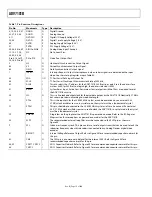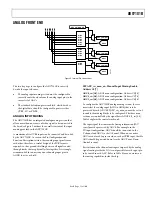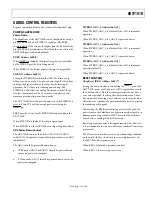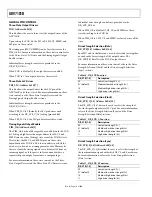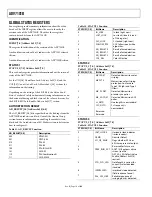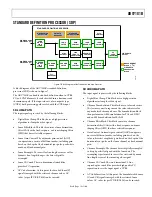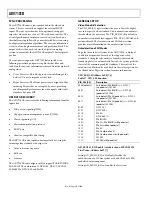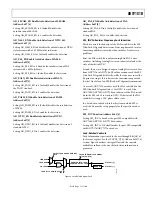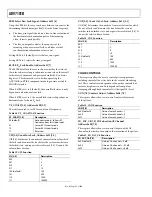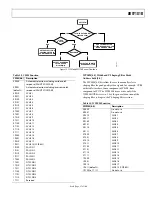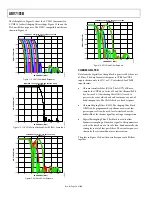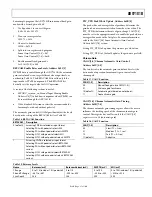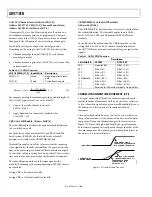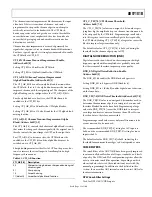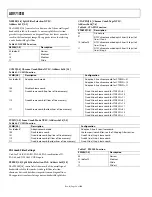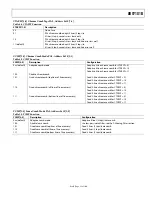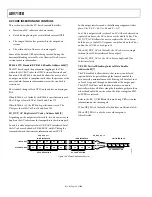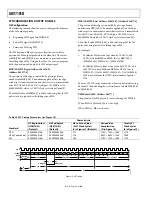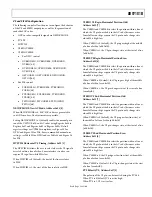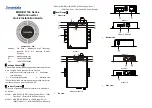
ADV7181B
Rev. B | Page 26 of 100
Y-Shaping Filter
For input signals in CVBS format, the luma shaping filters play
an essential role in removing the chroma component from a
composite signal. YC separation must aim for the best possible
crosstalk reduction while still retaining as much bandwidth
(especially on the luma component) as possible. High quality
YC separation can be achieved by using the internal comb filters
of the ADV7181B. Comb filtering, however, relies on the
frequency relationship of the luma component (multiples of the
video line rate) and the color subcarrier (Fsc). For good quality
CVBS signals, this relationship is known; the comb filter
algorithms can be used to separate out luma and chroma with
high accuracy.
With nonstandard video signals, the frequency relationship can
be disturbed and the comb filters may not be able to remove all
crosstalk artifacts in an optimum fashion without the assistance
of the shaping filter block.
An automatic mode is provided. Here, the ADV7181B evaluates
the quality of the incoming video signal and selects the filter
responses in accordance with the signal quality and video
standard. YFSM, WYSFMOVR, and WYSFM allow the user to
manually override the automatic decisions in part or in full.
The luma shaping filter has three control registers:
•
YSFM[4:0] allows the user to manually select a shaping
filter mode (applied to all video signals) or to enable an
automatic selection (dependent on video quality and video
standard).
•
WYSFMOVR allows the user to manually override the
WYSFM decision.
•
WYSFM[4:0] allows the user to select a different shaping
filter mode for good quality CVBS, component (YPrPb),
and S-VHS (YC) input signals.
In automatic mode, the system preserves the maximum possible
bandwidth for good CVBS sources (since they can successfully
be combed) as well as for luma components of YPrPb and YC
sources, since they need not be combed. For poor quality
signals, the system selects from a set of proprietary shaping
filter responses that complements comb filter operation to
reduce visual artifacts.
The decisions of the control logic are shown in Figure 10.
YSFM[4:0] Y-Shaping Filter Mode, Address 0x17[4:0]
The Y-shaping filter mode bits allow the user to select from a
wide range of low-pass and notch filters. When switched in
automatic mode, the filter is selected based on other register
selections, such as detected video standard, and also certain
properties extracted from the incoming video itself, such as
quality and time-base stability. The automatic selection always
picks the widest possible bandwidth for the video input
encountered.
•
If the YSFM settings specify a filter (such as, YSFM is set to
values other than 00000 or 00001), the chosen filter is
applied to all video, regardless of its quality.
•
In automatic selection mode, the notch filters are only used
for bad quality video signals. For all other video signals,
wideband filters are used.
WYSFMOVR Wideband Y-Shaping Filter Override,
Address 0x18[7]
Setting the WYSFMOVR bit enables the use of the
WYSFM[4:0] settings for good quality video signals. For more
information, refer to the general discussion of the luma shaping
filters in the Y-Shaping Filter section and the flowchart shown
in Figure 10.
When WYSFMOVR is 0, the shaping filter for good quality
video signals is selected automatically.
Setting WYSFMOVR to 1 (default) enables manual override via
WYSFM[4:0].

